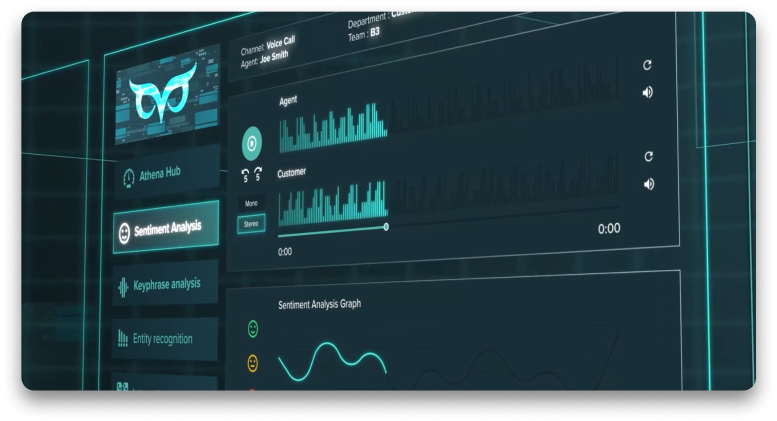Contact Center Analytics
Contact centers are crucial for brands to deliver exceptional customer experiences, serving as the primary support hub for customers. However, with the rising volume of interactions, maintaining high service quality and efficiency is increasingly challenging. Historically, call centers manually recorded calls to evaluate agent performance and tailor training programs. Today, modern contact center analytics, integrated within CCaaS solutions, utilize AI and machine learning, offering enhanced insights.
The concept of Call Center Analytics involves gathering and examining call center data to enhance various aspects such as customer experience, agent performance, customer service, and operational efficiency. This article will delve into the benefits and types of analytics necessary for maximizing these advantages.
What are Contact Center Analytics?
Call Center Analytics encompasses the collection and analysis of call center data to improve different facets including customer experience, agent performance, customer service, and operational efficiency. While optimizing internal reporting is an important aspect of call center analysis, its primary objective is to offer actionable insights that facilitate better decision-making, deeper customer understanding, and improved business processes through data-driven problem-solving.
CCaaS platforms equipped with interaction analytics features simplify the monitoring and reporting tasks, enabling companies to monitor and assess additional call center metrics accurately, clearly, and effortlessly.
Supervisors can swiftly address unforeseen issues with real-time activity alerts and notifications, preventing potential escalation. Modern analytics software leverages advanced AI technology, personalized dashboards, real-time updates, and behavioral predictions.
Data collection and analysis procedures can be automated, tailored, and condensed into easily shareable reports, furnishing comprehensive insights into key performance indicators (KPIs) like average call handle time, daily call volume, and cost per call.
How do you Analyze data in a call center?
1. Choose your tools wisely
Lacking the proper speech and text analytics tools and platform to consolidate your insights will hinder your contact center analytics. It is crucial to ensure you possess a robust system capable of managing extensive volumes of call and other data, with the capacity to adapt and learn over time for optimization purposes. Merely scratching the surface with high-level, generalized insights won’t suffice; achieving deeper analysis necessitates the utilization of a highly integrated, sophisticated tool.
2. Define your metrics
To ensure your contact center agents meet goals and provide a satisfactory customer experience, it’s essential to establish clear KPIs and monitor performance consistently. Avoid solely focusing on cutting costs; empower agents to effectively resolve customer queries in a way that benefits both parties and the business.
Here are some suggested metrics:
Traditional Contact Center KPIs
When establishing Key Performance Indicators (KPIs) for contact centers, typical metrics include average time to answer, abandonment rate, first call resolution (FCR), call transfer rate, average handle time, and agent compliance. With the integration of contact center analytics, these metrics can be expanded to include factors such as Net Promoter Score (NPS), Customer Effort Score (CES), and Customer Satisfaction (CSAT).
Ideally, measurement should focus on evaluating the customer experience during interactions, considering both customer and agent perspectives, and assessing subsequent actions taken.
Agent Performance Metrics
Contact center agents are commonly assessed based on the measurable aspects of their calls, yet resource constraints often prevent thorough tracking of all agents’ performances across their interactions. Utilizing software that analyzes agents’ interactions comprehensively, beyond just call metadata like duration and productivity, facilitates the tracking of customer satisfaction and subsequent actions taken.
Granting contact center leads access to insights provided by contact center analytics software enables them to evaluate an agent’s performance holistically, including improvements in customer experience across various metrics. Additionally, they can identify impactful actions by specific agents and integrate new suggestions into training programs.
CX Metrics
The quality of your customer experience is significantly influenced by their interactions with your contact centers. These centers serve as invaluable sources of insights into the challenges customers encounter and offer valuable feedback on resolving these issues.
Traditionally, assessing customer experience performance relies heavily on survey results like Net Promoter Score (NPS) and Customer Satisfaction (CSAT). However, with the utilization of contact center analytics, you can delve deeper into individual insights from each customer conversation in real-time. This approach moves beyond solely relying on customer feedback, enabling you to identify trends, comprehend sentiment, and gauge customer emotion on a broader scale.
By complementing this with predictive analytics like AI Forecasting, an AI functionality able to predict peak activity periods, you can proactively adjust processes preceding customer contact and track performance following these adjustments.
3. Facilitate actionable insights
Actionable insights are essential for value creation. While contact center analytics can deliver informative insights, the absence of business intelligence functionalities covering data integration and visualization can impede actionability.
Moreover, without such features, both macro and micro actions necessary for enhancing contact center performance may remain unidentified. Through appropriate features, you can uncover strategic gaps and individual-level issues that may impact customer satisfaction. For instance, a significant gap could entail a malfunctioning discount code leading to customer abandonment of your website, while a minor gap might involve improving a single customer’s experience by addressing frustration during a contact center call through a closed-loop action.
4. Adopt a holistic approach
While enhancing the performance of contact center agents or diminishing call waiting times can yield results, concentrating excessively on these improvements alone could diminish your overall business success. Effectively leveraging contact center analytics presents an opportunity to revamp processes and systems throughout your organization, ultimately boosting customer satisfaction by optimizing various touchpoints. Strive to transcend mere refinement of the contact center experience and instead, proactively overhaul processes to lower costs and enhance performance.
Contact Center Analytics Features
Sentiment Analysis
Sentiment Analysis is a pivotal aspect of call center management, employing sophisticated speech analytics AI to delve into the emotional nuances conveyed through the tone, choice of words, and rhythm of speech during customer interactions. By harnessing this technology, contact center managers gain invaluable real-time insights into the sentiments of customers, empowering them to optimize agent performance through targeted coaching sessions. This approach not only enhances the efficiency of individual agents but also contributes significantly to elevating overall customer satisfaction and fostering greater customer loyalty.
Moreover, the implementation of Sentiment Analysis cultivates a customer service environment characterized by heightened empathy and responsiveness. By understanding and addressing the emotional needs of customers more effectively, contact centers can tailor their responses and interactions to deliver truly exceptional customer experiences. This alignment with the overarching goal of providing outstanding service ensures that each customer interaction is handled with care and consideration, ultimately strengthening the relationship between the customer and the company.
In addition to Sentiment Analysis, speech analytics tools provide keyphrase analysis and Entity Recognition AI functionalities, expanding the scope of insights available to contact centers. Keyphrase analysis focuses on identifying commonly used words and phrases, generating detailed reports that aid in anticipating shifts in market trends. But that’s not all.
When integrated with an Automation Contact Center Software tool like Flow, Keyphrase Analysis can also be used to sort queries and direct them to the right agent based on parameters like skill required, topic, or language.
On the other hand, Entity Recognition AI detects specific entities mentioned during calls, such as company names or products, thereby facilitating more informed, data-driven decision-making processes. These advanced tools streamline the categorization and reporting of entity references during customer service interactions, significantly reducing the time and effort required for call assessment and routing tasks. This enhanced efficiency allows contact center staff to allocate their resources more effectively, ultimately leading to improved overall performance and customer satisfaction.
AI Forecasting
The inclusion of forecasting capabilities in an AI-based Contact Center platform brings strategic planning functionalities that greatly enhance an organization’s capacity to align its workforce with evolving business requirements. Through the utilization of advanced algorithms and historical data, forecasting emerges as a powerful tool for anticipating future workload patterns, enabling proactive decision-making and optimizing Workforce Management (WFM) processes.
A key benefit lies in the precise prediction of staffing needs. Through forecasting, organizations can anticipate peak workloads, seasonal variations, and other factors influencing workforce demands. This empowers managers to strategically plan shifts, allocate resources effectively, and maintain an optimal staffing level to meet demand, thus mitigating the risks associated with under or overstaffing and maximizing operational efficiency.
Furthermore, forecasting facilitates the alignment of call center workforce management with broader business objectives. By foreseeing fluctuations in demand, organizations can adjust staffing levels to support expansion, scale operations during busy periods, or implement cost-saving measures during slower periods. This strategic alignment enhances adaptability, enabling businesses to respond efficiently to changing market dynamics.
Speech analytics is an advanced technology that analyzes spoken words to deepen understanding of customer interactions, leveraging techniques like natural language processing, Automatic Speech Recognition and sentiment analysis.
The process involves transcribing spoken language, recognizing speech patterns, and identifying emotional tones and key phrases. This technology offers various applications in customer service, including monitoring call quality, analyzing customer feedback, evaluating agent performance, ensuring compliance, predicting customer behavior, resolving issues in real-time, and informing market research and product development.
If you enjoyed reading this, you might also be interested in…
Customer Service AI
Conversational AI
Contact Center Artificial Intelligence
Virtual Call Center
AI Based Call Center



